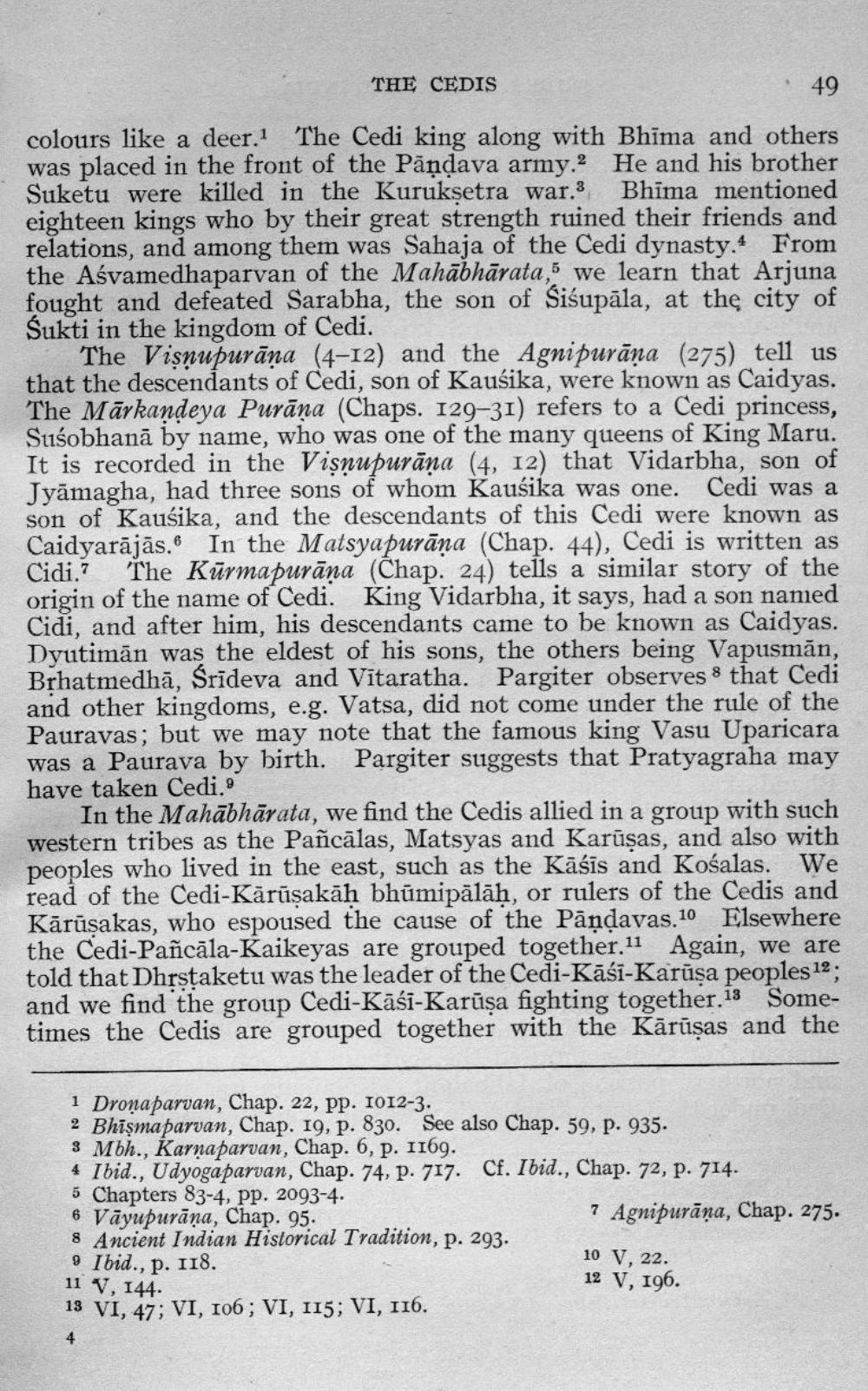________________
THE CEDIS
49 colours like a deer. The Cedi king along with Bhīma and others was placed in the front of the Pāņdava army. He and his brother Suketu were killed in the Kuruksetra war.3 Bhīma mentioned eighteen kings who by their great strength ruined their friends and relations, and among them was Sahaja of the Cedi dynasty.4 From the Aśvamedhaparvan of the Mahābhārata, we learn that Arjuna fought and defeated Sarabha, the son of Siśupāla, at the city of Sukti in the kingdom of Cedi.
The Vişnupurāna (4-12) and the Agnipurāna (275) tell us that the descendants of Cedi, son of Kausika, were known as Caidyas. The Mārkandeya Purāna (Chaps. 129-31) refers to a Cedi princess, Susobhanā by name, who was one of the many queens of King Maru. It is recorded in the Visnupurāna (4, 12) that Vidarbha, son of Jyāmagha, had three sons of whom Kausika was one. Cedi was a son of Kausika, and the descendants of this Cedi were known as Caidyarājās. In the Matsyapurāņa (Chap. 44), Cedi is written as Cidi.? The Kūrmapurāna (Chap. 24) tells a similar story of the origin of the name of Cedi. King Vidarbha, it says, had a son named Cidi, and after him, his descendants came to be known as Caidyas. Dyutimān was the eldest of his sons, the others being Vapusmān, Brhatmedhā, Srideva and Vitaratha. Pargiter observes 8 that Cedi and other kingdoms, e.g. Vatsa, did not come under the rule of the Pauravas; but we may note that the famous king Vasu Uparicara was a Paurava by birth. Pargiter suggests that Pratyagraha may have taken Cedi.
In the Mahābhārata, we find the Cedis allied in a group with such western tribes as the Pañcālas, Matsyas and Karūsas, and also with peoples who lived in the east, such as the Kāśis and Košalas. We read of the Cedi-Kārūsakāh bhūmipālāh, or rulers of the Cedis and Kārūsakas, who espoused the cause of the Pandavas.10 Elsewhere the Cedi-Pañcāla-Kaikeyas are grouped together.11 Again, we are told that Dhrstaketu was the leader of the Cedi-Kāśi-Karūsa peoples 12; and we find the group Cedi-Kāśi-Karūşa fighting together.13 Sometimes the Cedis are grouped together with the Kārūsas and the
1 Dronaparvan, Chap. 22, pp. 1012-3. 2 Bhīşmaparvan, Chap. 19, p. 830. See also Chap. 59, p. 935. 3 Mbh., Karnaparvan, Chap. 6, p. 1169. 4 Ibid., Udyogaparvan, Chap. 74, p. 717. Cf. Ibid., Chap. 72, p. 714. 5 Chapters 83-4, pp. 2093-4. 6 Vāyupurāņa, Chap. 95.
7 Agnipurāņa, Chap. 275. 8 Ancient Indian Historical Tradition, p. 293. 9 Ibid., p. 118.
10 V, 22.
12 V, 196. 13 V1, 47; VI, 106; VI, 115; VI, 116.
11 V, 144.




